The Life of a Scientist: Astrobiology in Iceland, Parts I and II
- By Christina Richey
- December 7, 2012
- Comments Off on The Life of a Scientist: Astrobiology in Iceland, Parts I and II
The Nordic-NASA Astrobiology Summer School “Water, Ice and the Origin of Life in the Universe,” was held July 1-15 in Iceland. The school was organized by Wolf Geppert, the director of the Stockholm University Astrobiology Center, and Karen Meech, the director of the NASA Astrobiology Institute at the University of Hawai’i. The school participants included 48 graduate students and post-doctoral fellows in the fields of biology, chemistry, geology, astronomy, and I was lucky enough to be one of those 48 selected. The school consisted of several methods for learning about the origins of life: lecturing from experts, poster sessions for the students, open discussions, excursions, and field work in extreme environments.
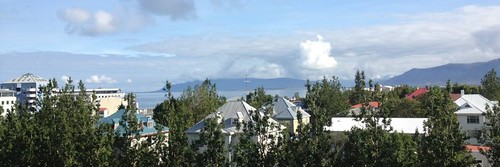
The view from our lecture hall in Reykjavik, Iceland. Photo courtesy of Christina Richey.

A typical Icelandic country road, lined with sheep. Photo courtesy of Christina Richey.
Part I: Lectures and Open discussions
Over the entire 2 weeks, approximately 40 hours of lecturing occurred. Experts were brought in from each field of interest in astrobiology to discuss topics that could lead to a thorough understanding of the Origin of Life. The first 3 days were spent participating in lectures from experts within the fields of the formation of elements in space, as well as astronomy and planetary science topics. The formation of water and organics is extremely important to life within our Universe, and this topic, from an astrobiological perspective, is well documented and studied in terms of the processes for forming water. Karen Meech gave a public talk on comets, as well as several detailed lectures on comet physics and asteroids to the school participants. Karen’s talk discussed the big unknowns for water on Earth; such as where did the Earth’s water content come from (how much from comets, hydrated asteroids, solar nebula gases, and chemical reactions on Earth) or even how much water is currently here on Earth. Jack Hunter Waite from South West Research Institute discussed icy satellites and highlights from the Cassini-Huygens mission. David Des Marais, a senior scientist at NASA Ames, led lectures on habitable environments and life, as well as future mission and the search for life of Mars. Brown University’s Jim Head instructed us on the ability to use Icelandic geology and terrain as an analog to the Martian surface, as the lack of vegetation and the igneous petrology is of interests to astrobiologists.

One of our guest lecturers and expert glaciologist, Þorsteinn Þorsteinsson of the Icelandic Meteorological Office, prepping for work on the Solheimajökull glacier, which is the southwestern outlet of the Mýrdalsjökull icecap. Photo courtesy of Sophie Nixon (PhD Student, University of Edinburgh, UK).
My first real opportunity to discuss volcanism came from Magnús Guðmundsson, from the University of Iceland, who discussed the history and formation of volcanoes in Iceland, as well as lectured us on one particular eruption that occurred in 2010: the Eyjafjallajökull (E-15 to those of us who cannot pronounce it) eruption. Many would remember this eruption as the one to cause major headaches across European airspace, but what I remembered were the magnificent multi-colored lightning strikes resulting from ash particles rubbing together, generating friction and electrical charges. We also learned of glaciology from Þorsteinn Þorsteinsson of the Icelandic Meteorological Office, who prepped us for our work on a glacier later in the school. Charles Cockell from Edinburgh University described life in icy environments, and Haraldur Sigurðsson from the University of Rhode Island described volcanic eruptions and their impact on human life. Haraldur is a rather famous volcanologist known for his reconstruction of major volcanic eruptions, as well as providing significant evidence to the theory that a meteorite impact of large proportion occurred at the time of the extinction of the dinosaurs (he discovered tektite glass pieces at the K-T boundary in Haiti). He is also well known for his 2004 discovery of the lost town of Tambora in Indonesia, which was buried under the 1815 eruption of Tambora volcano.
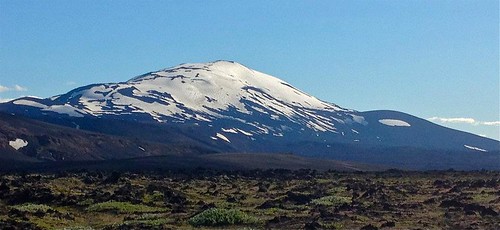
One of the many volcanoes we discussed while in Iceland, Hekla. Photo courtesy of Christina Richey.
One of the more interesting lectures came from BorgÞor Magnusson of the Icelandic Institute of Natural history, on the colonization of Surtsey. Surtsey is a volcanic island off the southern coast of Iceland and was formed from an eruption occurring in 1963. Wind and wave erosion have caused the land size above sea to decrease over time, and have been extensively studied by botanists and biologists as life forms slowly colonized the originally barren island. One of the major factors of life advancing on the island has been the expansion of bird life on the island, allowing for seeds to be distributed on the fertile ground. Gulls have been extremely important for this, as has the Atlantic Puffin. Other life on the island includes insects and grey seals, as well as sea urchin. Some higher forms of land life are also now appearing on the island, including earthworms, slugs, spiders, and beetles. Due to the great scientific value of the island, UNESCO declared the site a World Heritage Site in 2008.
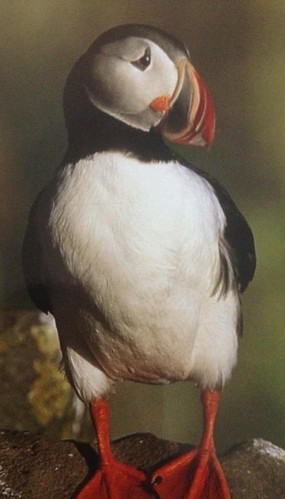
The Atlantic Puffin, or as we preferred to call it, a potato with wings. Photo from a random postcard photo while in Iceland.
Our lectures moved toward our primary objective (the origin of life) within the last few days, building upon the lectures from the previous week. John Baross from the University of Washington was the primary lecturer on the theories of the origin of life, while Nils-Kare Birkeland from the University of Bergen (Norway) and Jim Cleaves from the Carnegie Institute of Washington discussed extremophiles. Extremophiles are organisms that thrive in physically or geochemically extreme conditions that would otherwise be detrimental to most life on Earth (try surviving in a hot spring). Examples of extremophiles include mostly microbes. Microbes discovered 2.5 miles below sea level in the Mediterranean Sea survived in areas with salt concentrations ten times higher than typical seawater and pressures 400 times greater than what we feel here at the surface, as well as a lack of oxygen. Additionally, researchers have recently discovered new microbes living off the coast of Sicily, in ‘brine lakes,’ areas of extremely high concentrations of magnesium chloride. This survivability in extreme area give important clues as to the types of organisms that could survive in our outer solar system, such as on the surface of Titan, or possibly even in the deep oceans and ices of Enceladus or Europa.

David Cullen from Cranfield University (UK), and his son, watch as David Des Marais from NASA Ames Research Center photographs evidence of life in the Fimmvörðuháls lava field, the site of the 2010 eruption of the Eyjafjallajökull volcano. Photo courtesy of Christina Richey, after getting yelled at for moving a rock with an ungloved-hand while exclaiming “is that life I see?”
Additionally, poster sessions were held to allow each student the chance to present his or her PhD/postdoctoral work. One of the benefits to having a diverse group of students was the ability to network and collaborate with groups you’d typically never meet at conferences, which is extremely important in an ever-evolving field like astrobiology. Several open discussion occurred, allowing the students to discuss topics within their particular fields of interest and having a range of point of views. These topics including detecting biomarkers (indicators of a biological state) at large distances (such as through space observations), how similar an exoplanet must be to Earth to be able to develop life, and how likely are extremophiles to develop on Mars.
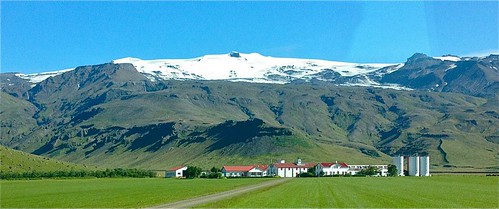
An Icelandic farmhouse situated below Eyjafjallajökull. Photo courtesy of Christina Richey.
Part II: Excursions into the wildly amazing parts of Iceland
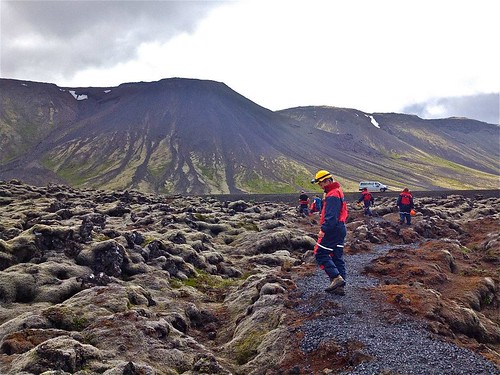
The Reykjanes Peninsula and the trail that lead to the entrance of the lava tube. Photo courtesy of Christina Richey.
Our first excursion was to the Reykjanes peninsula. This day was the first of many to highlight the importance of Iceland as an astrobiological wonderland, and why a school on the origin of Life (even in hostile conditions) should be held there. The peninsula is marked by active volcanism under its surface, and large lava fields, allowing little vegetation. Our excursion took us into one of the lava caves developed by these volcanoes. I quickly learned to never take a sheep into a lava tube, but that’s another story.
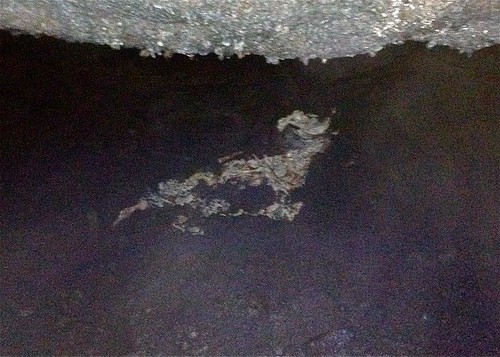
The remnants of a sheep that wondered in to the lava tube in the Reykjanes Peninsula. Don’t take sheep spelunking… Photo courtesy Christina Richey.
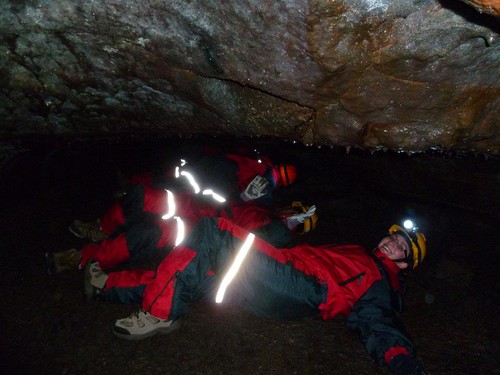
I’m handling this adventure much better than the sheep did. Photo courtesy of Christina Richey.
Additionally, there are numerous hot springs and sulphur springs in the Reykjanes peninsula, including the Krýsuvík geothermal area that was also part of our excursion. Hot springs are an important in Iceland, not on for the astrobiological applications, but also their energy applications. A geothermal power station is located here, and near the power station, a swimming pool has been installed using the hot and mineralized water coming down from the power station; it is known as the “Blue Lagoon” and is one of the tourist highlights of Iceland.
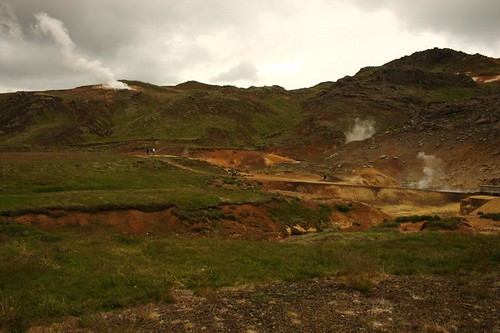
The Krýsuvík hot springs. Photo courtesy of Sophie Nixon (PhD Student, University of Edinburgh, UK).
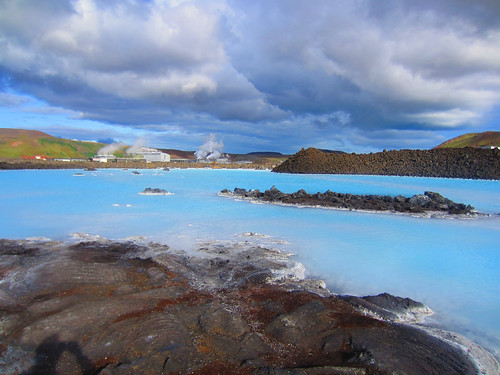
The Blue Lagoon and a geothermal power station. Photo courtesy of Ben Duffus (PhD Student, Montana State University).
Once our lectures turned towards the discussion of volcanoes, our venue changed and we spent a day travelling from Reykjavik to Hvolsvöllur, which is located in southern Iceland, in the heart of volcano and glacier country. On our travels to Hvolsvöllur, we stopped at Þingvellir. Þingvellir is a site of not only geological importance, but also historical and cultural significance, and is one of the most visited destinations in Iceland. The Parliament of Iceland was established in Þingvellir in 930 AD and remained there until 1789, and is now a protected site. Þingvellir is the site of a rift valley, marking the top of the Mid-Atlantic Ridge, and the drift between the North American and Eurasian Plates can be clearly seen in the cracks traversing across the region. Almannagjá, the largest of these cracks, is reminiscent of a smaller Grand Canyon. This drift often leads to earthquakes within the area. Þingvellir is also home to Þingvallavatn, the largest natural lake in Iceland.

Þingvellir, home of the Parliament of Iceland from 930-1789. Photo courtesy of Christina Richey.
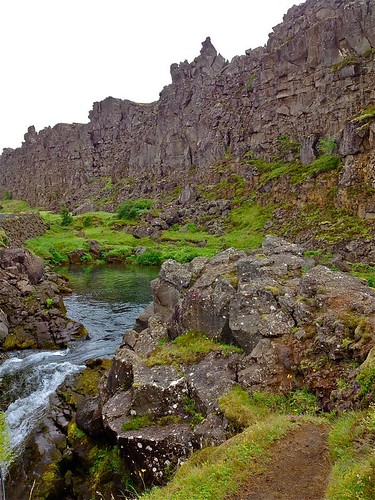
Þingvellir; the rift valley between the North Atlantic and Eurasian Plates. Photo courtesy of Christina Richey.
Another stop on our trip was to Geysir, a hot spring geyser in the southwest. Finally, our travel to Hvolsvöllur ended with an excursion to Gullfoss, a waterfall located in the canyon of the Hvítá River. Þingvellir, Geysir, and Gullfoss make up the “Golden Circle” in South Iceland, a popular tourist route.
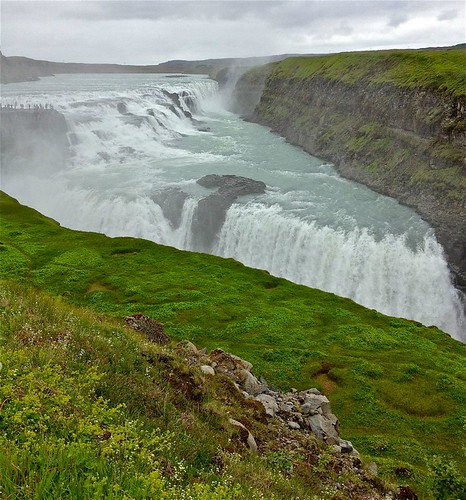
Gullfoss. Photo courtesy of Christina Richey.
Continue to parts III and IV.


